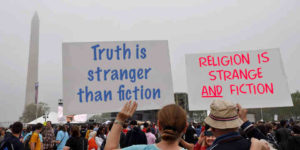The Bible says Jesus grew up in Nazareth, but what was life like in the first century village? Was Nazareth even a real place?
The publication in 2020 of a book and a paper by archaeologists who have spent years investigating sites in Nazareth has provided some clear answers. Here are 4 things we can know about ancient Nazareth.
1. Yes Virginia, there really was a Nazareth
The remains of first century Nazareth are mostly covered over by the modern city, making it difficult to investigate the archaeology. This lack of information has led some sceptics to suggest that Nazareth didn’t exist in the first century and the Gospel stories about it were invented.
But as the evidence accumulates, Nazareth-mythicism becomes increasingly difficult to sustain. Rene Salm, perhaps the strongest proponent of Nazareth-mythicism offers different explanations of the evidence from those of the archaeologists. But more recently he has begun to accuse archaeologists, historians and experts in coins and pottery, of outright incompetence, fraud and conspiracy.
Such accusations are about all that is left for him because there is now much evidence of a first century village.
Several rock-hewn kokhim tombs dating from middle to late first century have been found on the edge of the ancient village and in the nearby countryside. Only the wealthy could afford such tombs. Several tombs contained glass versions of lambs’ horn shofars used in Jewish worship. Perhaps some tombs were owned by priests who moved to Nazareth just before or after the Jewish uprising in 66-73 CE, or in the early 2nd century when there was another uprising.
Stone-walled terraces, a winepress, watchtowers and components of an irrigation system, together with dateable artefacts indicate a working farm in the first century, just a few hundred metres from the village.
Significant remains of two courtyard houses barely a hundred metres apart, again with dateable artefacts, indicate they were inhabited in the Roman-period, which included the first century. Both houses are partially cut into the natural bedrock, then stone and timber (presumably) was used to complete the house.
One house has three pits or cisterns cut from the bedrock for storage, but possibly also used to hide from Roman soldiers during the 66-73 CE uprising. The other house has a kokhim tomb cut into it, dated to late first century. Since it is cut into the natural rock wall of the house, that house must be dated earlier. In later centuries, this house was believed to be the home of Jesus’ family, and while there is no way to establish that, it seems likely that they lived in a house just like it.
Nearby, under the three adjacent Franciscan buildings are other underground rock-hewn silos, cisterns, grottos, basins, winepresses, and cellar stores with interconnecting corridors. These are similar to the smaller pits under one of the excavated houses, suggesting that further residences were located there before being removed to make way for the churches.
This is all clear evidence of a first century agricultural village.
2. Conservative and non-Roman
The inhabitants of first century Nazareth and the surrounding countryside were apparently religiously conservative and didn’t allow Roman customs to blur their Jewish identity.
- Most domestic artefacts indicate conformity to stricter versions of Jewish purity laws. Limestone cups and bowls were often used because they were considered unable to become ritually impure. Pottery was almost exclusively from a Jewish village 40 km away, which (presumably) also maintained strict purity laws. Underground pits were filled with broken pottery before the houses were abandoned, suggesting disposal of ritually defiled objects.
- Farming around Nazareth wasn’t fertilised with human excrement, in accordance with stricter purity laws. However closer to the Roman city of Sepphoris, about 7 km away, farmers were freer in their fertilising practices, and their homes also used a wider variety of pottery including non-Jewish ware. The archaeologists say the differentiation is quite distinctive and unusual.
- Towns nearby participated in the 67 CE revolt, and Yafi’a was destroyed. At Yodefat the Roman army searched hiding places in the town. The evidence suggests that the inhabitants of Nazareth also adapted, enlarged and connected their underground storage facilities to allow them to hide if necessary. It appears that Nazareth was not attacked by the Roman army, but the conservative villagers were probably sympathetic with the revolt.
This religious conservatism may be reflected in incidents recorded in the gospels of Jesus not being well received when he re-visited his home town, since Jesus’ teachings on purity tended to be more liberal.
3. Life in first century Nazareth
Most of the inhabitants were probably relatively poor (no imported or luxury items were found in the houses). They engaged in both farming and a trade to make a living. The farms probably grew olives, grapes, figs, almonds, wheat and barley.
The local limestone rock is relatively soft, so quarrying to make stone walls and stone domestic ware and excavating for houses or cisterns was a feature of Nazareth life. Jesus’ father Joseph is described as a tekton, often translated carpenter, but it is quite likely he also worked as a stone mason.
4. Nazareth history
The evidence suggests that Nazareth was settled in the Iron Age (9th or 10th century BCE) but later abandoned after the Assyrian invasion. It was re-settled by Jews from Judea (south of Galilee) in the late 2nd century BCE and the population grew slowly until the time of Jesus, when somewhere between 400 and 1,000 inhabitants lived there.
It appears that both the houses discussed here were later abandoned, one in the 1st century and one in the early 2nd century. There is little evidence of habitation for a century or two, but Nazareth was clearly inhabited in the 4th and 5th centuries. There is evidence of a synagogue or church at this time.
By the 5th century, Nazareth had become a pilgrimage site, and some of the buildings or ruins were associated with Jesus and his family (whether accurately or not is impossible to know). One of the houses recently documented was thought at that time to be the boyhood home of Jesus.
The historical Jesus
Whatever any of us may believe (or not) about Jesus as a prophet or Son of God, the argument that Nazareth didn’t exist and therefore Jesus didn’t exist either can be seen to be futile. Nazareth did exist in his lifetime and there is little reason to think anyone would invent a story of the Messiah coming from an obscure Galilean village. It is surely time for the Nazareth-sceptics to accept the evidence.
As Bart Ehrman (not a christian) concludes:
“No wonder this place is never mentioned in the Hebrew Bible, Josephus, or the Talmud. It was far too small, poor, and insignificant. Most people had never heard of it and those who had heard didn’t care. Even though it existed, this is not the place someone would make up as the hometown of the messiah. Jesus really came from there, as attested in multiple sources.”
Read more
For more about Nazareth archaeology, including a map and detailed references, see Were Bethlehem and Nazareth real places?
Photo: Tomb under present day Nazareth. The forecourt of this tomb cuts through a first century courtyard house which had been abandoned prior to the installation of the tombs. Bahnfrend, Wikipedia.




